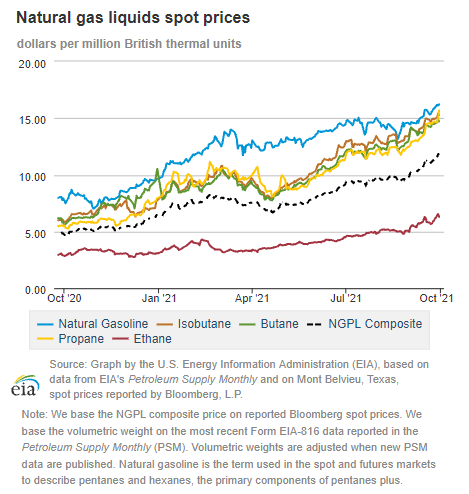In the News:
Europe’s natural gas storage inventories remain relatively low during the 2021 injection season
Working natural gas inventories in Europe have remained relatively low so far during this year’s injection season (defined as April through October), and totaled 2.7 trillion cubic feet (Tcf) as of September 28, 2021, or 74% of storage capacity, according to data from Gas Infrastructure Europe’s (GIE) Aggregated Gas Storage Inventory (AGSI+). Inventories as of Tuesday, September 28, 2021, were more than 0.75 Tcf (22%) below last year and over 0.5 Tcf (16%) below the five-year (2016–2020) average.
After a mild 2019–2020 winter and low natural gas consumption through 2020 as a result of COVID-related impacts on economic activity, Europe entered the 2020–21 heating season relatively well supplied, with inventories at more than 3.45 Tcf in mid-October – only 0.05 Tcf behind the prior year’s all-time record. Colder-than-normal weather late in the 2020–21 heating season, and a cold spell in April, led to rapid drawdowns of natural gas inventories early in 2021. As a result, Europe’s natural gas inventories entered the 2021 injection season 11% below the previous five-year (2016‒2020) average and 44% lower than the record-high storage inventories in 2020.
GIE reports that natural gas inventories are particularly low in Austria, Germany, and the Netherlands; on September 28, 2021, these countries held, respectively, 42%, 29%, and 35% less natural gas in storage than on the same day last year. Compared to the five-year average for September 28, Austria’s stocks at 0.16 Tcf were 38% lower, Germany’s natural gas stocks of 0.50 Tcf were 26% lower, and the Netherlands’ stocks at 0.27 Tcf were 35% lower.
In particular, natural gas stocks at the storage facilities owned by the Russian natural gas company Gazprom in Austria, Germany, and the Netherlands were at a combined total of 77 Bcf as of September 28, 2021, which is 75% (225 Bcf) below the five-year average on this date. Gazprom’s natural gas storage assets currently account for about 11% of the total storage capacity in the European Union. Compared to last year, as of September 28, 2021, Gazprom’s natural gas stocks in Austria are 77% lower, in Germany 74% lower, and in the Netherlands 71% lower, according to AGSI+ data.
Since the start of the current injection season, several factors have contributed to a slower pace of Europe’s natural gas injections this year:
- Continuing decline in Europe’s natural gas production. Gradual depletion of existing natural gas fields in Europe, and no significant new finds, have resulted in Europe’s natural gas production declining by 9% (1.9 Bcf/d) year over year, from 21.1 Bcf/d in the first half of 2020 to 19.2 Bcf/d in the first half of 2021. Production is 19% lower compared with the five-year average (23.8 Bcf/d) over the same period.
- Lower natural gas pipeline imports, particularly from Russia. Lower pipeline imports, due in part to a recent explosion at a major natural gas processing facility in northern Russia, have resulted in decreased natural gas supply during storage injection season.
- Lower liquefied natural gas (LNG) imports to Europe. As a result of strong demand recovery in Asia and increased competition for spot LNG cargos, spot LNG shipments to Europe have decreased year over year, mainly from the United States. Natural gas send-out from Europe’s LNG import terminals has been at a three-year low, averaging 7.2 Bcf/d (April through September), which is 18% lower than the 2020 average (8.7 Bcf/d), and 22% lower than the 2019 average (9.2 Bcf/d) during the same period, according to data from the GIE’s Aggregated LNG Storage Inventory (ALSI).
In addition, outages at LNG production facilities in several countries contributed to reduced global LNG supply, particularly in the summer months of this year. Lower European natural gas storage inventories and strong LNG demand recovery in Asia have led to all-time high seasonal natural gas and LNG spot prices, exceeding $30 per million British thermal units (MMBtu) in Europe and in Northern Asia at the end of September 2021, according to data by Bloomberg Finance, L.P.
Overview:
(For the week ending Wednesday, September 29, 2021)
- Natural gas spot prices rose at most locations this report week (Wednesday, September 22, to Wednesday, September 29). The Henry Hub spot price rose from $4.83 per million British thermal units (MMBtu) last Wednesday to $5.63/MMBtu yesterday.
- International natural gas prices rose for the fifth consecutive week. Bloomberg Finance, L.P. reports swap prices for November liquefied natural gas (LNG) cargos in East Asia rose to a weekly average of $27.96/MMBtu this report week, the highest weekly average on record going back to January 2020 and $3.99/MMBtu above last week’s average of $23.98/MMBtu. At the Title Transfer Facility (TTF) in the Netherlands, the most liquid European natural gas spot market, day-ahead prices averaged $25.23/MMBtu this report week, the highest weekly average on record going back to September 2007 and up $1.95/MMBtu from last week’s average of $23.28/MMBtu. In the same week last year (week ending Sep. 30, 2020), prices in East Asia and at TTF were at $5.00/MMBtu and $4.11/MMBtu, respectively.
- The October 2021 NYMEX contract expired Tuesday at $5.841/MMBtu, up $1.04/MMBtu from last Wednesday. The November 2021 NYMEX contract price increased to $5.477/MMBtu, up 62¢/MMBtu from last Wednesday to yesterday. The price of the 12-month strip averaging November 2021 through October 2022 futures contracts climbed 34¢/MMBtu to $4.507/MMBtu. Yesterday’s settlements were highest for the winter months, with December futures settling at $5.60/MMBtu, January futures settling at $5.68/MMBtu, and February contract settling at $5.56/MMBtu. The February futures contract settled at $6.06/MMBtu on Tuesday, the highest settlement for any futures contract since the March 2014 contract settled at $6.14/MMBtu on February 21, 2014.
- The net injections to working gas totaled 88 billion cubic feet (Bcf) for the week ending September 24. Working natural gas stocks totaled 3,170 Bcf, which is 15% lower than the year-ago level and 6% lower than the five-year (2016–2020) average for this week.
- The natural gas plant liquids composite price at Mont Belvieu, Texas, rose by 40¢, averaging $11.57/MMBtu for the week ending September 29. Ethane prices rose by 6% to $6.21/MMBtu, more than the 5% increase in natural gas prices at the Houston Ship Channel. For the fourth consecutive week, the ethane premium to natural gas widened, increasing 13% to 97¢/MMBtu for the week ending September 29. Ethane prices are at their highest level since October 2018. Normal and isobutane prices rose 2%, natural gasoline prices rose 3%, and propane prices rose 4%, following the 4% increase in Brent crude oil prices. The propane premium to crude oil did not change for the week ending September 29, leveling off at $1.80/MMBtu.
- According to Baker Hughes, for the week ending Tuesday, September 21, the natural gas rig count decreased by 1 to 99, as a result of a one-rig loss in the New York State portion of the Marcellus. The number of oil-directed rigs rose by 10 to 421. Oil-rig gains were highest in Louisiana, which gained 4, reflecting a return to off-shore exploration and production activities following Hurricane Ida. The oil rig count in Oklahoma also rose by 4, and the rig count in Texas rose by 3, offset by a one-rig loss in Utah. The total rig count increased by 9, and it now stands at 521, the highest level since mid-April 2020.
Prices/Supply/Demand:
Prices on the Gulf Coast increase, reflecting continuing supply-demand imbalance in the region. This report week (Wednesday, September 22 to Wednesday, September 29), the Henry Hub spot price rose 80¢ from $4.83/MMBtu last Wednesday to $5.63/MMBtu yesterday, after reaching a weekly high of $5.93/MMBtu on Tuesday. Gulf Coast natural gas markets remain tight. Lower power consumption in the region, as a result of cooler weather and reduced air conditioning demand, resulted in average weekly natural gas consumption for power generation declining by 910 million cubic feet per day (MMcf/d) in Texas and by 890 MMcf/d in the Southeast according to data from IHS Markit. Weekend temperatures in the Houston Area were below-normal over the weekend, at 86ºF on Saturday and Sunday, 3ºF and 2ºF below normal, respectively, resulting in 5 fewer cooling degree days (CDD – a measure of air conditioning demand) on Saturday and 4 CDDs on Sunday, relative to normal weather. In the prior week, by comparison, there were 3 CDDs more in the Houston Area on both Saturday and Sunday. To a large extent, the reduced power generation demand was offset by increased feed gas deliveries to LNG export terminals. IHS Markit reports LNG feed gas rose on average week over week, by 140 MMcf/d in Louisiana and 630 MMcf/d in Texas, reflecting a return to full capacity at the Freeport LNG terminal, which was idle for part of the last report week due to impacts of Hurricane Nicholas.
Production on the Gulf Coast remains impaired. The final report from the Bureau of Safety and Environmental Enforcement (BSEE), released on September 23, reports 540 MMcf/d of natural gas production remained impaired due to impacts from Hurricane Ida, which made landfall on August 26. At least 400 MMcf/d of this total is due to a continuing outage on Shell-operated West Delta 143 (WD-143) platform. The off-shore platform, which aggregates crude oil and natural gas flows from Shell-operated offshore fields Olympus, Mars, and Ursa, was severely damaged during Hurricane Ida. Shell expects production, including natural gas flows, from the Olympus production facility to re-start sometime next quarter, and production from Mars and Ursa to restart sometime in the first quarter of 2022. Enbridge, operator of the Mississippi Canyon Gas Pipeline that brings natural gas onshore from Shell’s WD-143 platform, and the Venice natural gas processing plant in Plaquemines Parish, Louisiana, reports the plant is operational (Notice ID 112697), but currently not receiving feed gas. Prior to the hurricane, Enbridge reported flows of approximately 120 MMcf/d from Olympus, and 270 MMcf/d from Mars and Ursa combined. Flows fell to zero on August 28, and remain at this level today.
Prices in the Midwest increase as temperatures remain unseasonably high. At the Chicago Citygate, the price increased 64¢ from $4.65/MMBtu last Wednesday to $5.29/MMBtu yesterday. The price at the Chicago Citygate reached a weekly high of $5.44/MMBtu on Tuesday, reflecting rising power generation demand throughout the week as a result of unseasonably-high temperatures. Average temperatures in Chicago reached a high this week of 87ºF on Monday, 13ºF above normal, and remained above normal on Tuesday and yesterday. Natural gas demand for power generation in the Midwest rose above 2.8 Bcf/d at the end of the report week, according to IHS Markit, more than 1.2 Bcf/d above the level reported at the start of the report week.
Continuing pipeline constraints keep prices elevated in the West. The price at PG&E Citygate in Northern California rose 31¢, up from $6.72/MMBtu last Wednesday to $7.03/MMBtu yesterday, after reaching a weekly high of $7.26/MMBtu on Tuesday. Prices at PG&E rose by less than prices at the Henry Hub or in Southern California (see section below), reflecting a more balanced market this report week. Temperatures in the Sacramento Area averaged 66ºF yesterday, 4ºF below normal, resulting in 1 CDD, 4 CDDs below normal. Last Wednesday, September 22, the daily average temperature was 77.5ºF, 6ºF above normal, resulting in 6 CDDs more than normal. The lower CDDs resulted in reduced natural gas consumption in the power generation sector, which fell in California by 190 MMcf/d on average week over week.
The price at SoCal Citygate in Southern California increased 70¢ from $6.39/MMBtu last Wednesday to $7.09/MMBtu yesterday. Prices in Southern California fell to a low of $6.05/MMBtu on Friday, and rose to a weekly high of $7.29/MMBtu on Tuesday. Price volatility in the Southern California market may persist for the next two weeks as SoCal Gas issued a critical notice on September 27 announcing the start of maintenance at the Aliso Canyon storage facility, the largest natural gas storage facility in the region, resulting in no capacity available for storage injections or withdrawals between September 28 and October 13, reducing the ability of the system to balance supply and demand. Supply into the SoCal Gas service territory remains constrained, due to a continuing outage on the El Paso Natural Gas (EPNG) Line 2000 in Arizona, after Kinder Morgan declared force majeure on August 15, affecting flows of natural gas from the Permian Basin. According to data from IHS Markit, flows westbound from the Permian Basin averaged 2.6 Bcf/d this report week, compared with 3.3 Bcf/d for the report week before the force majeure was declared (August 4-August 11).
Prices in the Northeast increase this week, despite lower consumption. At the Algonquin Citygate, which serves Boston-area consumers, the price went up 51¢ from $4.39/MMBtu last Wednesday to $4.90/MMBtu yesterday. At the Transcontinental Pipeline (Transco) Zone 6 trading point for New York City, the price increased 47¢ from $4.22/MMBtu last Wednesday to $4.69/MMBtu yesterday. Consumption in the Northeast decreased this week driven by consumption in the electric power sector, which declined 1.3 Bcf/d, or 16%, according to data from IHS Markit. Temperatures in the Boston Area were comfortable this week, averaging in the high 60s. Volumes of feed gas to LNG facilities in the Northeast also declined this week to 0 Bcf/d as maintenance (notice ID 124379) at the Cove Point LNG terminal continued. Despite lower week-on-week consumption of natural gas in the Northeast, prices at the Algonquin Citygate and the Transco Zone 6 trading point increased, following a trend of higher prices across the country.
Prices in the Appalachian Basin production region rise, reflecting an increase in southbound flows. The Tennessee (TGP) Zone 4 Marcellus spot price increased 58¢ from $4.02/MMBtu last Wednesday to $4.60/MMBtu yesterday. The price at Eastern Gas South in southwest Pennsylvania rose 67¢ from $3.98/MMBtu last Wednesday to $4.65/MMBtu yesterday. Prices in the region tracked developments in the Gulf Coast market, where the Henry Hub price also reached a weekly high on Tuesday. IHS Markit estimates southbound flows out of the Appalachian Basin production region rose on average 0.7 Bcf/d week over week, as a result of continuing strong demand on the Gulf Coast.
Permian production region prices rise, but by less than the Henry Hub, due to continuing constraints on the EPNG pipeline. The price at the Waha Hub in West Texas, which is located near Permian Basin production activities, rose 53¢/MMBtu this report week, from $4.52/MMBtu last Wednesday to $5.05/MMBtu yesterday. The Waha Hub traded 58¢/MMBtu below the Henry Hub price yesterday, compared to last Wednesday when it traded 31¢/MMBtu below the Henry Hub price. The increasing discount at Waha relative to the Henry Hub reflects reduced ability for Permian producers to reach the premium Southern California market due to the EPNG outage (see California section above). Permian production has remained depressed, averaging approximately 8.4 Bcf/d for the past three weeks, more than 0.5 Bcf/d below Permian production in the three weeks before the pipeline rupture.
U.S. supply of natural gas increased this report week as a result of increasing imports from Canada. According to data from IHS Markit, the average total supply of natural gas rose by 0.5% compared with the previous report week. Dry natural gas production decreased by 0.1% (0.1 Bcf/d) compared to the previous report week, but was more than offset by a 12.2% (0.6 Bcf/d) increase in average net imports from Canada.
U.S. consumption declines for the second week in a row, led by lower fuel use in the electric power sector. Total U.S. consumption of natural gas fell by 5.7% compared with the previous report week, according to data from IHS Markit. Natural gas consumed for power generation declined by 13.1%, or 4.3 Bcf/d, week over week as a result of cooler-than-normal temperatures in both the Southwest and the Southeast. Industrial sector consumption increased by 1.4% week over week. In the residential and commercial sectors, consumption increased by 5.0%, or 0.4 Bcf/d, to 9.3 Bcf/d. Natural gas exports to Mexico decreased 2.5% week over week. Natural gas deliveries to U.S. liquefied natural gas (LNG) export facilities (LNG pipeline receipts) averaged 10.1 Bcf/d, or 0.35 Bcf/d higher than last week.
U.S. LNG exports decrease week over week. Seventeen LNG vessels (five each from Sabine Pass and Freeport, four from Corpus Christi, and three from Cameron) with a combined LNG-carrying capacity of 63 Bcf departed the United States between September 23 and September 29, 2021, according to shipping data provided by Bloomberg Finance, L.P.
Storage:
The net injections into storage totaled 88 Bcf for the week ending September 24, compared with the five-year (2016–2020) average net injections of 72 Bcf and last year's net injections of 74 Bcf during the same week. Working natural gas stocks totaled 3,170 Bcf, which is 213 Bcf lower than the five-year average and 575 Bcf lower than last year at this time.
According to The Desk survey of natural gas analysts, estimates of the weekly net change to working natural gas stocks ranged from net injections of 70 Bcf to 95 Bcf, with a median estimate of 87 Bcf.
The average rate of injections into storage is 12% lower than the five-year average so far in the refill season (April through October). If the rate of injections into storage matched the five-year average of 9.1 Bcf/d for the remainder of the refill season, the total inventory would be 3,506 Bcf on October 31, which is 213 Bcf lower than the five-year average of 3,719 Bcf for that time of year.
More storage data and analysis can be found on the Natural Gas Storage Dashboard and the Weekly Natural Gas Storage Report.
See also:
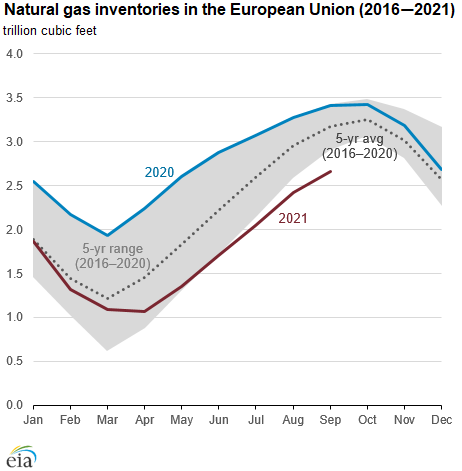 Source: Graph by the U.S. Energy Information Administration, based on data from Gas Infrastructure Europe Aggregated Gas Storage Inventory (AGSI+)
Source: Graph by the U.S. Energy Information Administration, based on data from Gas Infrastructure Europe Aggregated Gas Storage Inventory (AGSI+) Note: The natural gas storage inventory levels are shown as of September 28 for 2021 and as of last day of the month for January 2016 through August 2021. European Union totals (based on AGSI+ reporting) include United Kingdom stocks at: SSE, Storengy UK, and Uniper Energy Storage. Stocks are converted from terawatthours to billion cubic feet at 3,602 kilowatthours per cubic foot.
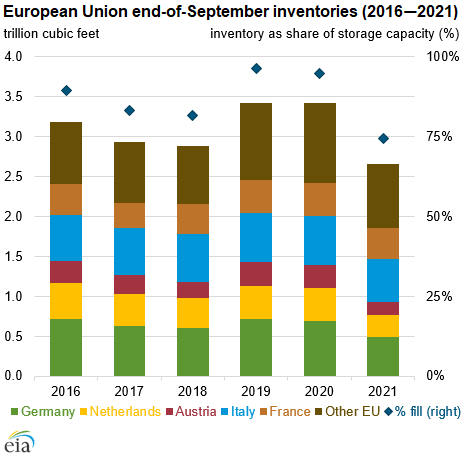 Source: Graph by the U.S. Energy Information Administration, based on data from Gas Infrastructure Europe Aggregated Gas Storage Inventory (AGSI+)
Source: Graph by the U.S. Energy Information Administration, based on data from Gas Infrastructure Europe Aggregated Gas Storage Inventory (AGSI+) Note: Natural gas storage inventory levels are shown as of September 28 for each of the years. Storage fill percentages are calculated by AGSI+.
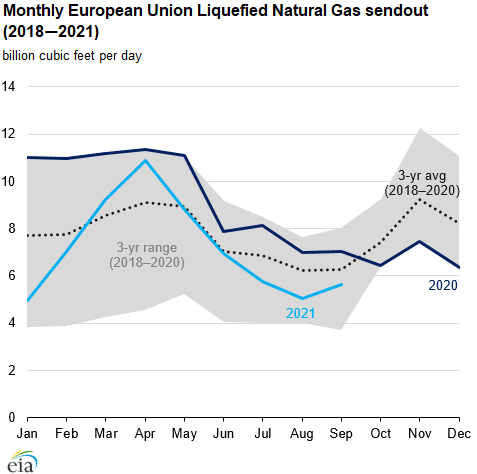 Source: Graph by the U.S. Energy Information Administration, based on data from Gas Infrastructure Europe Aggregated LNG Storage Inventory (ALSI)
Source: Graph by the U.S. Energy Information Administration, based on data from Gas Infrastructure Europe Aggregated LNG Storage Inventory (ALSI) Note: LNG monthly average sendout for September 2021 includes days 1-27.
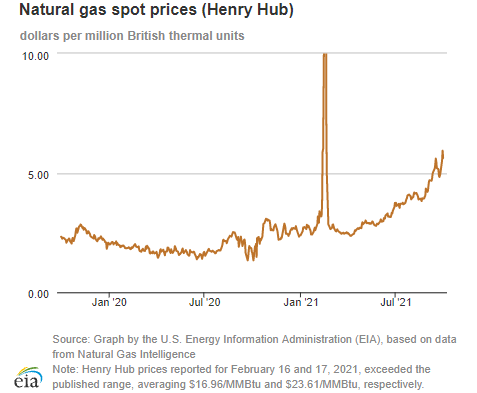
| Spot Prices ($/MMBtu) | Thu, 23-Sep |
Fri, 24-Sep |
Mon, 27-Sep |
Tue, 28-Sep |
Wed, 29-Sep |
|---|---|---|---|---|---|
| Henry Hub | 4.90 | 5.02 | 5.52 | 5.93 | 5.63 |
| New York | 4.25 | 3.93 | 4.41 | 4.71 | 4.69 |
| Chicago | 4.65 | 4.49 | 5.07 | 5.44 | 5.29 |
| Cal. Comp. Avg.* | 5.89 | 5.78 | 6.37 | 6.43 | 6.28 |
| Futures ($/MMBtu) | |||||
| October Contract | 4.976 | 5.140 | 5.706 | 5.841 | Expired |
| November Contract | 5.043 | 5.200 | 5.731 | 5.880 | 5.477 |
| December Contract | 5.157 | 5.315 | 5.839 | 5.985 | 5.595 |
| *Avg. of NGI's reported prices for: Malin, PG&E Citygate, and Southern California Border Avg. | |||||
| Source: NGI's Daily Gas Price Index | |||||
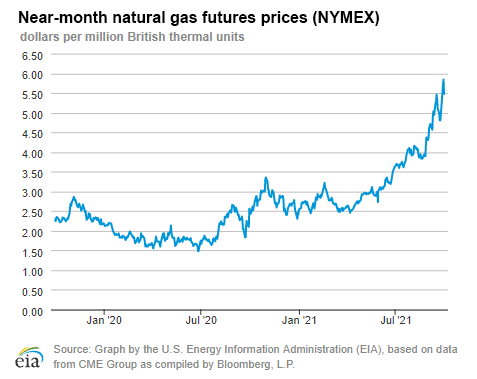
| U.S. natural gas supply - Gas Week: (9/23/21 - 9/29/21) | |||
|---|---|---|---|
Average daily values (billion cubic feet) |
|||
this week |
last week |
last year |
|
| Marketed production | 104.1 |
104.1 |
99.4 |
| Dry production | 92.4 |
92.5 |
87.6 |
| Net Canada imports | 5.5 |
4.9 |
3.6 |
| LNG pipeline deliveries | 0.1 |
0.1 |
0.1 |
| Total supply | 98.0 |
97.4 |
91.2 |
|
Source: Chart by the U.S. Energy Information Administration (EIA), based on data from IHS Markit | |||
| U.S. natural gas consumption - Gas Week: (9/23/21 - 9/29/21) | |||
|---|---|---|---|
Average daily values (billion cubic feet) |
|||
this week |
last week |
last year |
|
| U.S. consumption | 59.5 |
63.1 |
63.4 |
| Power | 28.7 |
33.0 |
32.9 |
| Industrial | 21.5 |
21.2 |
21.7 |
| Residential/commercial | 9.3 |
8.9 |
8.7 |
| Mexico exports | 5.6 |
5.7 |
6.2 |
| Pipeline fuel use/losses | 6.1 |
6.2 |
6.0 |
| LNG pipeline receipts | 10.1 |
9.8 |
5.9 |
| Total demand | 81.3 |
84.8 |
81.4 |
|
Source: Chart by the U.S. Energy Information Administration (EIA), based on data from IHS Markit | |||
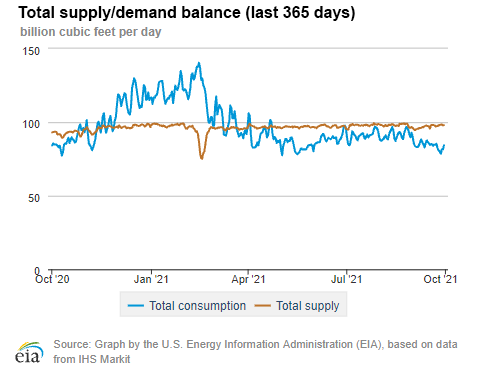
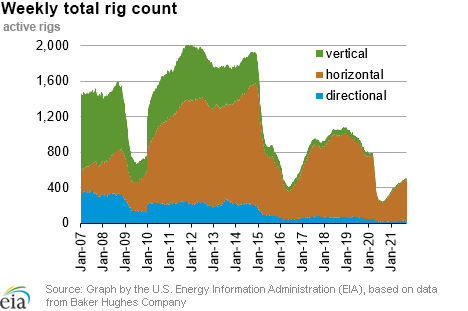
| Rigs | |||
|---|---|---|---|
Tue, September 21, 2021 |
Change from |
||
last week |
last year |
||
| Oil rigs | 421 |
2.4% |
130.1% |
| Natural gas rigs | 99 |
-1.0% |
32.0% |
| Note: Excludes any miscellaneous rigs | |||
| Rig numbers by type | |||
|---|---|---|---|
Tue, September 21, 2021 |
Change from |
||
last week |
last year |
||
| Vertical | 30 |
3.4% |
87.5% |
| Horizontal | 471 |
1.1% |
110.3% |
| Directional | 20 |
17.6% |
-4.8% |
| Source: Chart by the U.S. Energy Information Administration (EIA), based on data from Baker Hughes Company | |||
| Working gas in underground storage | ||||
|---|---|---|---|---|
Stocks billion cubic feet (Bcf) |
||||
| Region | 2021-09-24 |
2021-09-17 |
change |
|
| East | 779 |
751 |
28 |
|
| Midwest | 934 |
904 |
30 |
|
| Mountain | 201 |
196 |
5 |
|
| Pacific | 243 |
240 |
3 |
|
| South Central | 1,013 |
990 |
23 |
|
| Total | 3,170 |
3,082 |
88 |
|
|
Source: U.S. Energy Information Administration Form EIA-912, Weekly Underground Natural Gas Storage Report | ||||
| Working gas in underground storage | |||||
|---|---|---|---|---|---|
Historical comparisons |
|||||
Year ago (9/24/20) |
5-year average (2016-2020) |
||||
| Region | Stocks (Bcf) |
% change |
Stocks (Bcf) |
% change |
|
| East | 869 |
-10.4 |
831 |
-6.3 |
|
| Midwest | 1,030 |
-9.3 |
958 |
-2.5 |
|
| Mountain | 230 |
-12.6 |
211 |
-4.7 |
|
| Pacific | 315 |
-22.9 |
298 |
-18.5 |
|
| South Central | 1,301 |
-22.1 |
1,085 |
-6.6 |
|
| Total | 3,745 |
-15.4 |
3,383 |
-6.3 |
|
| Source: U.S. Energy Information Administration Form EIA-912, Weekly Underground Natural Gas Storage Report | |||||
| Temperature – heating & cooling degree days (week ending Sep 23) | ||||||||
|---|---|---|---|---|---|---|---|---|
HDDs |
CDDs |
|||||||
| Region | Current total |
Deviation from normal |
Deviation from last year |
Current total |
Deviation from normal |
Deviation from last year |
||
| New England | 11 |
-29 |
-61 |
17 |
16 |
17 |
||
| Middle Atlantic | 3 |
-27 |
-57 |
29 |
20 |
29 |
||
| E N Central | 18 |
-16 |
-35 |
30 |
21 |
29 |
||
| W N Central | 24 |
-14 |
-13 |
29 |
15 |
20 |
||
| South Atlantic | 2 |
-8 |
-29 |
74 |
19 |
29 |
||
| E S Central | 6 |
-3 |
-10 |
57 |
15 |
24 |
||
| W S Central | 3 |
0 |
-2 |
90 |
17 |
31 |
||
| Mountain | 32 |
-10 |
20 |
36 |
2 |
-14 |
||
| Pacific | 7 |
-6 |
4 |
26 |
-1 |
-16 |
||
| United States | 11 |
-13 |
-21 |
45 |
14 |
18 |
||
|
Source: Chart by the U.S. Energy Information Administration (EIA), based on data from the National Oceanic and Atmospheric Administration Note: HDDs=heating degree days; CDDs=cooling degree days | ||||||||
Average temperature (°F)
7-day mean ending Sep 23, 2021
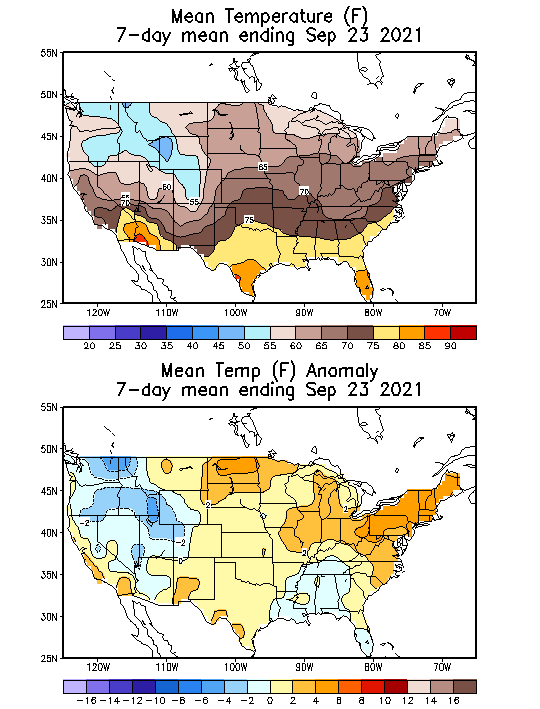
Source: National Oceanic and Atmospheric Administration
Deviation between average and normal (°F)
7-day mean ending Sep 23, 2021

Source: National Oceanic and Atmospheric Administration

